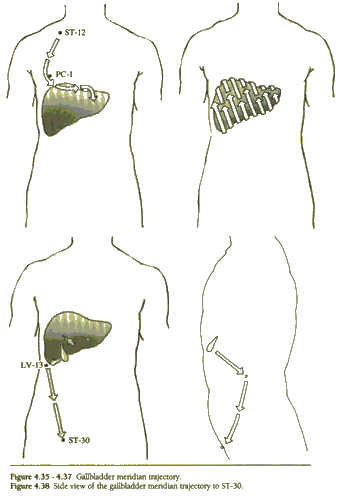
Gallbladder: Wood-energy yang organ

Gallbladder:
Wood-energy yang organ
Known as the 'Honorable Minister', the gall bladder is in charge of the 'Central Clearing Department'. It secretes the pure and potent bile fluids required to digest and metabolize fats and oils, and its energy provides muscular strength and vitality. It works with the lymphatic system to clear toxic by-products of metabolism from the muscular system, thereby eliminating muscular aches and fatigue. In the Chinese system, the common tension headache is caused by obstruction in the gall-bladder meridian, which runs up over the shoulders and back of the neck to the top of the head and forehead. Hence such headaches are usually accompanied by neck and shoulder tension.
The gall bladder governs daring and decisiveness. In Chinese, the word for 'daring' is da dan ('big gall'). The English language also acknowledges this psychophysiological relationship with the phrase 'a lot of gall'. An old Chinese adage states: 'The gall bladder is daring, the heart is careful', which reflects the stimulating generative influence of Wood to Fire.
|
Gallbladder |
|
| Paired Organ | Liver |
| Color | yellow green |
| Peak Hours | 11pm-1am |
| Mental Qualities | resentment |
| Physical Branches | eyes, tendons, tears, nails |
| Functions | stores and excretes bile, one of the Six Extraordinary Organs |
Gall Bladder: Psycho-Emotional Aspects
The Gall Bladder is responsible for making decisions and judgments, as well as providing courage and initiative. This organ is sometimes called the Court of Justice or The General's Advisor. Although the Kidneys control drive and vitality, the Gall Bladder provides the capacity to turn this drive and vitality into decisive action. The Gall Bladder has an influence on the quality and length of sleep. If the Gall Bladder is Deficient, the patient will often wake up suddenly, very early in the morning, and be unable to fall asleep again. Patient's who are timid, indecisive, and easily discouraged by slight adversity, are said to have a weak Gall Bladder; conversely, decisive and determined patients are said to have a strong Gall Bladder.
The Gallbladder Channel Pathway, Acupuncture Points, and Internal Trajectories
This channel begins just outside the outer corner of the eye, loops down and up to the forehead just within the hair line, and descends behind the ear to the corner of the skull. It then returns to the forehead above the center of the eye and contours the head to the bottom of the skull at GB-20. It continues down the neck behind the shoulder to connect with the governing vessel at GV-14, then crosses over the shoulder. The channel descends the side of the body along the rib margin to the waist and pelvic crest before going deeper to meet the bladder channel at the sacrum. At GB-30 it re-emerges and continues down the outside of the leg, in front of the ankle, ending on the outside of the 4th toe. Internal branches connect with the stomach channel (on the jaw) and the small intestine channel, and join the liver and gallbladder organs.

Internal Trajectories of the Gallbladder Meridian
Having come down from the head, a trajectory passes to ST-12.
[Thence] it passes to the inside of the chest and then down. It passes through the diaphragm, spirally wraps the liver and permeates the gallbladder. Then it circles round the inside lining of the ribs and the side of the body and comes down to ST-30
In this case, "the inside of the chest" is seen as the sides of the chest, around PC-1. In general, we should be aware that the inside of the chest has a wider meaning which depends on context. It can be inside the chest, CV-17, the sides of the chest, as well as some other less common referents. In coming down through the diaphragm it probably passes through the esophagus and then the stomach, before it passes to and spirally wraps the liver. After this, it permeates the gallbladder. In circling around on the inside of the lining of the ribs and the sides of the body it passes out to LV-13, and then to ST-30.
